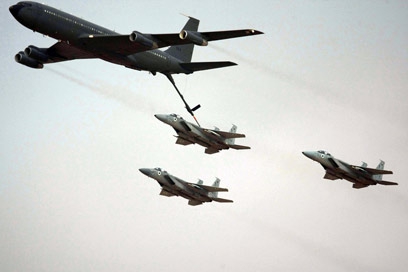Friday 21 September 2012 - 10:56
Story Code : 6002
Expert: Israeli strike on Iran's nuke sites would be folly
In-depth analysis of possibility of military strike against Islamic Republic highlights Israel's weak points; states lack of refueling jets, massive ordinance penetrator bombs as major drawback.
Israel's weak spots in a possible strike against�Iran�are placed under the spotlight yet again:�An in-depth analysis written by Dr. Josef Joffe from Stanford University for the International Institute for Strategic Studies presents the difficulties�Israel�will be faced with should it decide to go ahead and bomb the Islamic Republic's�nuclear facilities.
In his paper Joffe explains that Israel does not have a bomb that can destroy the�Fordo�underground facility near�Qom, expands on the fact that Israel would have to fly over hostile countries en route to Iran and focuses on the lack of refueling jets.
The article, which was published along a series of articles on security matters in the 'Security Times,' opens with a description of the MOP bomb: "The Massive Ordnance Penetrator, the most powerful explosive device in the American arsenal," writes Joffe.
"Six meters long and weighing 14 tons. The monster bomb is built to bore through concrete 60 meters thick before its 2.5-ton explosive charge detonates. It would be the weapon of choice to wipe out the deeply bunkered Iranian enrichment facility at Fordo, near Qom."
According to Joffe, the US air force ordered MOPs when the Fordo facility was uncovered, the first were delivered last fall. Israel does not have MOPs or American B2 bombers, which would be used to transport the bombs if the Americans attack. Yet Fordo is only one of the problems Israel is facing.
Another difficulty in a�military strike�against Iran is the distance. Out of the eight central air force targets in the Islamic Republic, only the Arak facility is reachable without refueling.
"An F-16I 'Storm' flies very high in very thin air, with extra fuel tanks it can cover 1500 km. Yet if it flies low to evade radar in Jordan, Iraq and Iran, its combat radius shrinks by half. The F-15I 'Thunder', the IAF�s mightiest jet probably has similar specs: 1000 to 1500 kilometers.
Joffe goes on to explain in detail why it just is not enough: "The pilots would have to turn back about a hundred kilometers short of the enrichment sites at Fordo and�Natanz. If they were to fly on anyway, they would have to refill their tanks over territory that�s not exactly friendly:�Jordan�and Iraq using the direct route; or, on the northern variant, along the Syrian-Turkish border.
"They could fly undetected only over the sea, around the Arabian Peninsula. That would mean 5000 kilometers: an absurd venture�Geography, then, remains Israel�s foremost enemy, one that can be overcome only by midair refueling."
Yet refueling might be Israel's main problem, says Joffe: "Israel has only five tanker jets modified Boeing 707s. Time for some mental math: The IAF has 100 Storms and 25 Thunders. If they�re all deployed at once, they would have to be refueled twice, on each leg of the mission. 125 times two equals 250 � with a handful of tankers?
"Then with half the fleet, perhaps? That wouldn�t change much either, because bombers have to arm themselves against fighters and ground-to-air missiles. The Iranians� 50-odd fighters (F-14s, Mirages and MiG-29s) may be old to obsolete, but still have to be reckoned with."
In line with American assessments claiming that Israel cannot destroy all of Iran's nuclear facilities, and would only be able to delay Tehran's efforts to achieve nuclear capability, Joffe believes that the IDF would choose to hit a few of targets rather than all eight of them.
He concludes that the air force might try to take out key components in the nuclear supplies chain by destroying the enrichment facility at Natanz, which is more vulnerable than Fordo, as well as the uranium converter facility at Isfahan.
Joffe explains that without the possibility of converting uranium to gas, Iran would be forced to halt enrichment activities.
The Iran Project is not responsible for the content of quoted articles
# Tags











